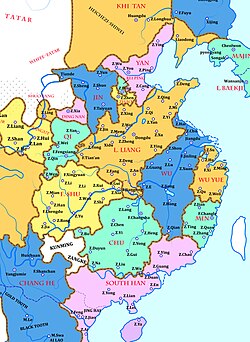Later Liang (Five Dynasties)
| Liang | ||||||||||||
| 梁 | ||||||||||||
|
||||||||||||
| Capital |
Luoyang (907-913) Kaifeng (913-923) |
|||||||||||
| Languages | Middle Chinese | |||||||||||
| Government | Monarchy | |||||||||||
| Emperor | ||||||||||||
| • | 907–912 | Emperor Taizu | ||||||||||
| • | 912–913 | Zhu Yougui | ||||||||||
| • | 913–923 | Emperor Modi | ||||||||||
| Historical era | Five Dynasties | |||||||||||
| • | Established | June 1, 907 | ||||||||||
| • | Surrender of Kaifeng | November 19, 923 923 | ||||||||||
|
||||||||||||
| Today part of |
|
|||||||||||
The Later Liang (simplified Chinese: 后梁; traditional Chinese: 後梁; pinyin: Hòu Liáng) (June 1, 907–923) was one of the Five Dynasties during the Five Dynasties and Ten Kingdoms period in China. It was founded by Zhu Wen, posthumously known as Taizu of Later Liang, after he forced the last emperor of the Tang dynasty to abdicate in his favour (and then murdered him). The Later Liang would last until 923 when it was destroyed by Later Tang.
Zhu Wen initially allied himself as Huang Chao’s lieutenant. However, he took Huang’s best troops and established his own power base as a warlord in Kaifeng. By 904, he had exerted control over both of the twin Tang Dynasty capitals of Chang'an and Luoyang. Tang emperor Zhaozong was ordered murdered by Zhu in 904 and the last Tang emperor, Ai Di (Emperor Ai of Tang), was deposed three years later. Emperor Ai of Tang was murdered in 908, also ordered by Zhu.
Meanwhile, Zhu Wen declared himself emperor of the new Later Liang in Kaifeng in 907. The name Liang refers to the Henan region in which the heart of the regime rested.
The Later Liang controlled most of northern China, though much of Shaanxi (controlled by the Qi) as well as Hebei (controlled by the Yan state) and Shanxi (controlled by Shatuo Turks) remained largely outside Later Liang control.
...
Wikipedia

